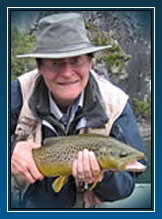 |
here reporting live from Boston. Taking a break from my nightly fly tying. By day I paint fine and not so fine homes. Hmmmm, what to say. Oh, you should never ask a girl how old she is, but I'll tell you anyway. I am 45.
I am on the Board of Directors for the North East Council, and am the NEC Fly Tying Chair. Teaching is a big part of my life. I offer many courses at various locales and am an instructor at and president of United Fly Tyers. I seem to manage to tye at a bunch of shows, events and clubs. The shows range from big and well-known to small and unknown. Of note, I was selected as the Fly Fishing Team USA official fly tyer in 2006 and traveled with the team to the Fly Fishing World Championships in Portugal. I am also on several manufacturers pro-teams.
Living in Boston gives me the opportunity to tye and fish saltwater flies in addition to fresh water flies, which are my primary interest. My flies are available via my website at www.ityeflies.com. When I am not painting houses or tying flies, I enjoy reading, cooking, sports (playing and watching) and the fine art of enjoying life.
It would be important for the Fly Tying Group to formulate and make available guidelines for tying instructors so that each person teaching fly tying does not have to reinvent the process anew. This might include lesson plans, recipe suggestions for students at different skill levels, materials checklists, and guidelines for effective communication and teaching. This may also be translated into a document or video containing guidelines for demonstration tying as well. It seems important to preserve our fly tying heritage. In addition to a museum setting this should also be done digitally so as to make our valuable information more widely available for research. I also feel we need to better utilize the FFF Forum as a structured way for tyers to communicate with one another.
|